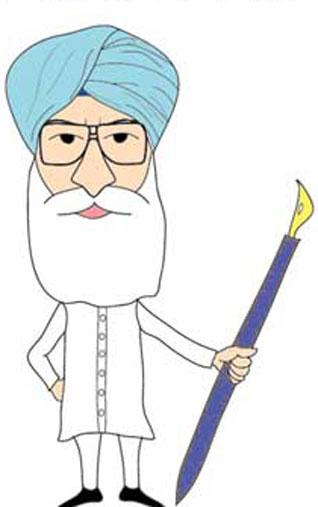
Images, above and thumbnail: details from cartoon by Vishavjit Singh (www.sikhtoons.com). Below, images of Sikhs today: First from bottom, courtesy - Anthony Begovic. Second from bottom: Singer Rabbi Shergill. Third from bottom, courtesy - Fiona Aboud.



Books
Sirdar Kapur Singh:
A True Luminary
A Book Review by MANJYOT KAUR
A celebration of one of the most monumental works of Bhai Sahib Sirdar Kapur Singh, a towering figure in both Sikh Polity and Letters during much of the 20th Century, in continuing commemoration of his Birth Centenary in 2009.
SIKHISM FOR MODERN MAN, by Sirdar Kapur Singh. Edited by Madanjit Kaur and Piar Singh. Guru Nanak Dev University, Amritsar, 2006 (5th ed.). ISBN 81-7770-002-2. 193 pages. Price: Rs. 150.
BOOK REVIEW
On every page of this work by Sirdar Kapur Singh, National Professor of Sikhism, his immensely profound scholarship and extraordinarily perceptive interpretations of Sikhi blaze forth.
Unquestionably a true luminary of Sikhi and often considered to be the faith's leading theologian, Kapur Singh possessed an intellectual arsenal of utterly awesome proportions, which he displays most masterfully throughout this book.
Written during his fatal illness and posthumously published for the first time in 1992, six years after his death, it is the final product of his formidable pen.
[It should be noted that it also appeared in 1993 in a slightly altered version entitled Sikhism: An Oecumenical Religion, produced by Chandigarh's Institute of Sikh Studies under the editorship of Gurtej Singh.]
A thoroughly satisfying serving of the incredibly copious feast of knowledge that is Kapur Singh's thought, it aims to foster understanding of the uniqueness of Sikhi among the religions of the world. Besides providing an absorbing examination of what the author terms the "phenomenality of Sikhism," it delves into the fundamental elements of Sikh identity and the major postulates of Sikh philosophy with the monumental erudition so characteristic of Kapur Singh's labyrinthine mind.
Dedicated to "The Modern Man who is woefully in search of Peace and Truth," considerable emphasis is placed upon the timeless and universal elements of Sikhi, stressing its potential as a viable way of life for contemporary society, capable of meeting today's spiritual and secular needs and aspirations.
A "Key to Transliteration" and a short list of "Abbreviations" are helpful additions to the preliminary sections of this book, which also include a Foreword by G.S. Randhawa, Vice-Chancellor of Guru Nanak Dev University.
The first chapter, "Retreat from and Return to Religion," explores both the creation and reversal of the centuries-long trend of "sentimental and intellectual revulsion" from religion (especially Christian institutions of the West) and the consequent idealization of science and technology first sparked by the discoveries of the Renaissance.
The resultant secularization of society created "a disquietude-filled human mind," which soon found that burgeoning technology belied its high hopes of "ushering in a new era of limitless, abundant and unalloyed happiness for mankind on earth." Now knit into a de facto global society, man's earnest search for an alternative worldview has stimulated a deep yearning for "a religion which is available to all castes and colours, all races and nationalities."
In the author's opinion, Sikhi amply meets this urgent need.
The next chapter, a lengthy section entitled, "Phenomenality of Sikhism," posits that "there is no real antagonism between Science and Religion, as religion implicates an activity which is independent of scientific activity and relates to a category of experience which is neither confirmed nor falsified by whatever the scientific discoveries or speculations may reveal or establish."
It goes on to declare that true religious activity revolves around man's attempt to establish contact with "the Numenon," the "Ultimate Reality which lies at the base of all phenomena." Sikhi, according to Kapur Singh, is uniquely poised to be "the religion of the Numenon," as the essence of its theory is the "Practice of the Name," expressly designed for achieving consciousness of and contact with the Numenon.
Consistently putting forth Sikhi as a completely unique religion, and highlighting, where appropriate, the faith's interactions with and struggles against Hinduism and Islam, a fascinating recitation of the lives and acts of Sikhi's ten Gurus follows, heavily emphasizing their doctrinal continuity.
Kapur Singh convincingly sums up the essence of Sikh History when he states:
"The historical Sikh Gurus claim no more than that they can help man, through teaching, to cultivate his religious intuition so as to awaken the Divine Light within. (...) In all the Sikh Gurus, it was the same Light and the identical Spirit that historically and successively manifested itself. (...) After the tenth Guru, this Light has been deposited in the Sikh Scripture, the Guru Granth, and the Spirit continues to operate in the historically permanent Mystic Body of the committed Sikhs, the Holy Congregation of those who follow this Light. This is the Sikh doctrine of the Condominium of the Granth and the Panth."
The third chapter, "The Heart of Sikhism," opines that "the true end of man is not a Vision of God that ends in re-absorption of the individual into the Absolute Reality." Rather, Sikhi, as a "Religion of the Way," must be experienced in "the mundane world of phenomena," so that man may fulfill his role of spiritualizing and transforming earthly existence by leading a life of the highest ethical purity and realization of the Divine Light within us all.
Chapter IV, "The Sikh Thought," deals with an array of cosmic and esoteric concepts, ranging from the "Genesis of the Universe" to "Evil." In it, Kapur Singh puts forth a plethora of complex ideas - for example, supporting the reality of "the world of appearances," and stressing man's key mission to not only live in harmony with the Divine Will, but also "divinize the whole of humanity on this earth by transforming mind, life, and matter through conscious effort." His monumental knowledge of comparative religion is certainly in particular evidence in this section.
In the next two brief chapters, "Social Implications of Sikhism" and "A Perspective," the worth and status of the individual as a microcosm of the Divine "Universal Mind," as well as the need for awareness of and close communion with this Absolute Reality are highlighted. These sections also emphasize the centrality of the three basic doctrines of Sikhi (Naam Japo, Kirat Karo, Wand Chhako) in everyday life in cooperative modern society.
Chapter VII, "The Axial Ritual," discusses the rite of Amrit and its formulation by the Tenth Master, Guru Gobind Singh, at the inauguration of the Khalsa. It is a truly inspiring and motivational "must-read" for anyone considering undergoing the Sikh initiation ceremony, and is guaranteed to bring back many stirring reminiscences for anyone who has already been blessed to become Amritdhari.
The last chapter, "Sikh Congregational Prayer," is a cogent and smooth-flowing English version of the Ardaas. Kapur Singh's translation is quite beautiful and succeeds in bringing out a wealth of subtle nuances of meaning - valuable qualities that many, if not most, other English versions sorely lack.
A Bibliography, a Doctrinal Index of Concepts and Terminology, and a General and Bibliographical Index conclude this work. These three components would certainly be of use to readers who want further information regarding sources used by the author and/or want to locate specific ideas, names and titles referred to in the text.
Indisputably the product of a towering intellect, Sikhism for Modern Man is, without any doubt, of major worth for serious students of Sikhi. It is also one of those lovely and all-too-rare books that makes all Sikhs (regardless of their degree of personal observance) justifiably rejoice in the glorious beauty and true uniqueness of our faith.
Moreover, for those fortunate enough to have already been in this work's thrall during a previous reading experience, it is eminently worth delving into anew. It loses none of its freshness or impact upon repeat perusals; on the contrary, I found it even more edifying and powerful during this, my second complete go-through. (Many more cover-to-cover readings will follow in the future for me, I am sure.)
A pithy and penetrating exegesis of the tenets of the Sikh faith, it is also of inestimable value for those on their first steps of their journey of exploring Sikhi (Sikhs and non-Sikhs alike). They will find the section in the second chapter on the lives of the Ten Masters especially worthwhile.
Kapur Singh's commitment to Sikhi as a completely distinct religion with timeless and universal relevance is absolutely evident.
This is a veritable treasure-trove of a book that relatively inexperienced readers of Sikhi-related writing who are still a bit unsure when it comes to "separating the wheat from the chaff" should not fear approaching, in terms of ideology.
However - a word of warning - they need to be intrepid souls who possess enough motivation to make a considerable and consistent effort to mine the often well-obscured nuggets of wisdom this author offers. As Kapur Singh is renowned (or should it be "notorious"?) for his mind-blowingly dense prose, all will surely not be clearly understandable at first glance. But, in this case, assiduous "pick-and-shovel" efforts will always be rewarded!
Furthermore, those readers who do not know the Gurmukhi script and have scant familiarity with Guru Granth Sahib must be prepared to encounter Gurbani quotes that include transliterations but have no English translation whatsoever. They will need to resort to looking them up in a version of Guru Granth Sahib that includes a translation, as page numbers have been provided.
This total lack of English translation for the scriptural quotations is the book's most glaring weakness, and one that absolutely begs to be rectified in a future edition.
These caveats firmly aside, I consider Sikhism for Modern Man, along with what I think of as its "sister tome," Parasaraprasna, to be among the most brilliant jewels of my personal Sikhi library. It never fails to ignite and delight my mind!
Dear readers, I sincerely hope it will do the same for yours!
[Manjyot Kaur is a Senior Editor of sikhchic.com.]
March 30, 2009
Conversation about this article
1: Gurparvez Singh Cheema (U.S.A.), March 30, 2009, 3:18 PM.
Just ordered this from an Amazon.com 3rd party vendor. Thanks, Manjyot, for the insightful review. Looking forward to the read!
2: Major Pannu (Fort Lauderdale, Florida, U.S.A.), April 04, 2009, 9:46 AM.
I wish I could have access to such enlightening views on Sikhism, more often.
3: Satnam (India), May 02, 2009, 4:18 AM.
A really interesting article.
4: Captain Dr. Mohinder Singh (Patiala, Punjab), January 14, 2012, 9:34 AM.
I have hurriedly gone over the article to know more about the great Sirdar, since I had met him in October, 1969 in the canteen of the Punjab Vidhan Sabha. I was accompanied by my son, now a medico - Dr. Parmvir Singh - who was then of 7-8 years. Sirdar Kapur Singh was then a Punjab legislator and the cHief Minister was Justice Gurnam Singh. The Sirdar hugged my son with words of blessings: "Puttar, pooran gursikh banay!" Since he was known as the "angry man" of politics, I whispered to him in politely: "If go a little cool to get into Sikh politics in Punjab, you will be at the helm of affairs and be able to bring in all sorts of required reforms." "I have to be like this only!" he retorted gruffly. It was a couple of days later when Sardar Darshan Singh Pheruman breathed his last on the 74th day of his fast and the whole of the Justice Gurnam Singh cabinet and other legislators rushed to the site to take stock of the situation. Pheruman had fasted for inclusion of Chandigarh in Punjab. Sant Fateh Singh was President of the Akali Dal and Sant Chanan Singh was the S.G.P.C. chief. Very soon, they played into the hands of our present CHief Minister and the government failed, to be taken over again in 1971 under the stewardship of Parkash Singh. The rest is history.
5: Chinder (Italy), June 11, 2012, 7:16 AM.
I want to read his books.


